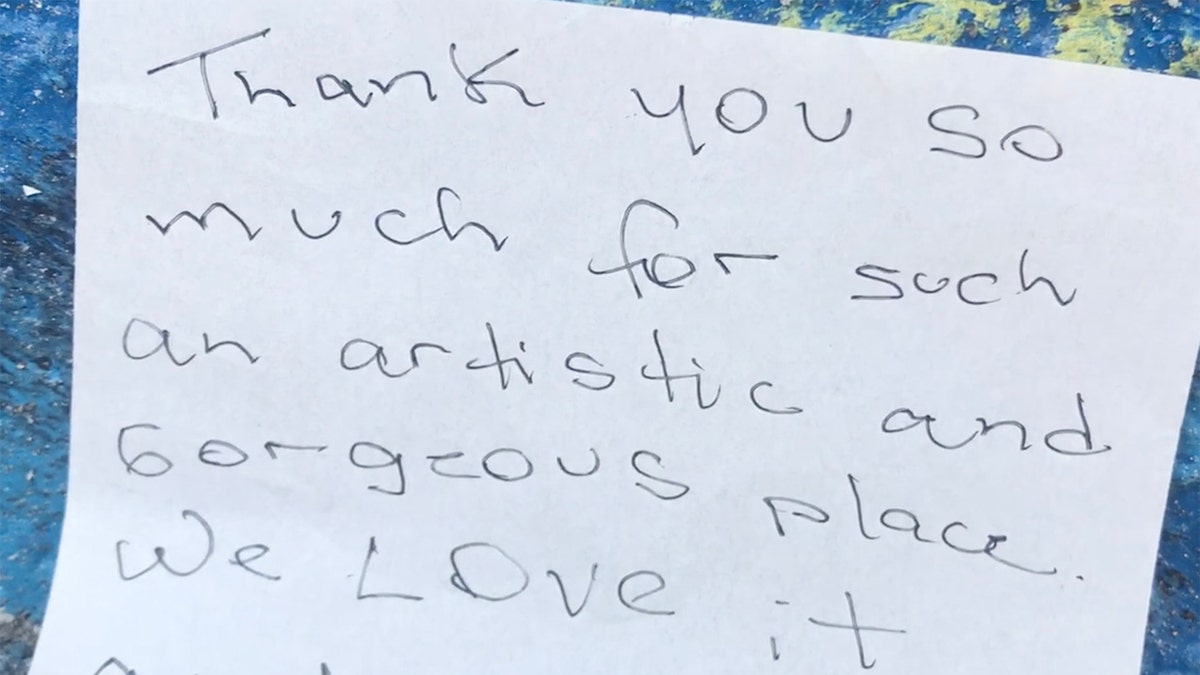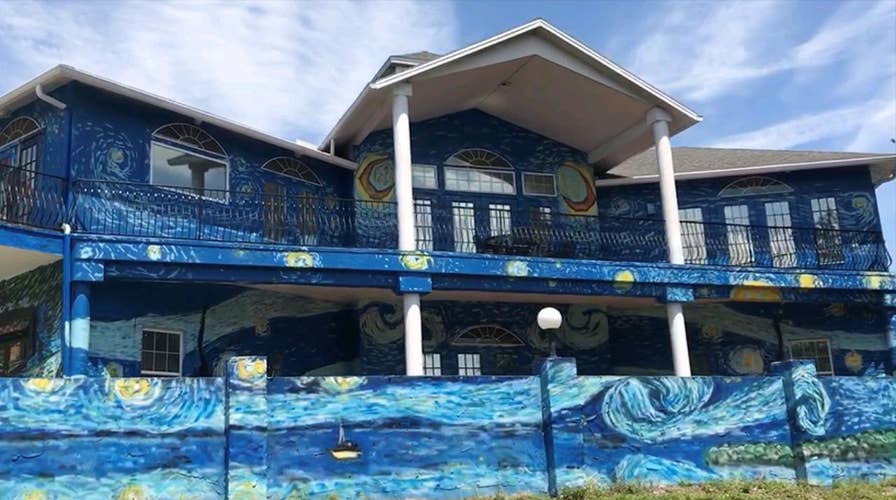'Starry Night' homeowners fight city over First Amendment
A Central Florida home is at the center of a standoff between the city and homeowners after Van Gogh’s iconic 1889 painting was recreated on the home.
MOUNT DORA, Fla. – In a picturesque city known for its artsy charm just outside Orlando, Fla., a house adorned with blue and yellow swirls is stuck in the middle of a First Amendment dispute that has pitted city hall against the homeowners.
“The City of Mount Dora has made our lives a nightmare,” said Nancy Nemhauser, who owns the home with her husband Ludomir Jastrzebski.
When Vincent Van Gogh’s iconic 1889 painting “Starry Night” was recreated on the home last July, Mount Dora officials called it an eyesore. The city slapped the homeowners with a graffiti violation and $3,100 fine, then charged them $100 a day, up to the value of the house, until the mural was painted over. They were given 30 days to comply or faced steeper fines.
The dispute has received national attention because of the house’s unique design. Its also, critics say, the latest example of government overreach, with the city playing favorites over which house murals get to stay and which ones cannot.
“This isn’t just a case of homeowners’ rights vs. the big bad government or the good government vs. the bad homeowner,” said Michael Allan Wolf, a professor at University of Florida’s Levin College of Law. “I suspect the only reason the local government got involved in this case is because there are complaints from other homeowners.”

When Vincent Van Gogh’s iconic 1889 painting “Starry Night” was recreated on the home last July, Mount Dora officials called it an eyesore. The city slapped the homeowners with a graffiti violation and $3,100 fine, then charged them $100 a day, up to the value of the house, until the mural was painted over. They were given 30 days to comply or faced steeper fines. (Fox News)
The city soon after abandoned its original graffiti claim and replaced it with a “sign” violation.
A 2015 Supreme Court ruling makes it difficult for municipalities to favor some signs and prohibit others.
“If local homeowners aren’t happy with this house,” Wolf said, “they should file a public nuisance lawsuit, but I don’t think they can really prove this is a public nuisance.”
The fines had grown to $10,600 when the homeowners filed a temporary restraining order against the city through their California-based Pacific Legal Foundation attorney, Jeremy Talcott, who took the case to federal court to stop the accruing charges.
Talcott argued that the home painted in the style of the masterpiece is an expression of the owners’ First Amendment rights and that the city’s application of what was a “sign” not allowed under code was inconsistent and vague.

The dispute has received national attention because of the house’s unique design. It’s also, critics say, the latest example of government overreach, with the city playing favorites over which house murals get to stay and which ones cannot. (Fox News)
“How would you like to pay for your First Amendment? $100 a day,” said Jastrzebski, a Polish immigrant. “I came to this country and I appreciate the value of my constitutional rights.”
The couple said they have paid no money to the City of Mount Dora.
“If everyone else must paint their houses one color, then I’m happy to do that if that’s the code, but that’s not the code and they’re making it up as they go,” said Nemhauser of the multiple homes with murals in Mount Dora. “If our house is a sign, then any other house with artwork on it is also a sign.”
The homeowners said the colorful mural was intended to serve as a sort of landmark and beacon for their adult autistic son, Chip, in case he got lost and couldn’t find his way home. They hope he can one day live in the home with his caretakers.
They claim they told the city their plan before the project began and were told by three city employees that no special permits were required to begin painting. Nemhauser said she took the necessary steps before the artist, Richard Barrenechea, began painting.

The homeowners (above right) said the colorful mural was intended to serve as a sort of landmark and beacon for their adult autistic son, Chip, in case he got lost and couldn’t find his way home. They hope he can one day live in the home with his caretakers. (Fox News)
“I wanted to be absolutely certain,” she said.
The couple first commissioned the rendition of “Starry Night” for the 40-foot-wall in front of their home. But before the wall was even finished, the city sent the homeowners a graffiti notice and ordered that the wall and house must match.
After the citation, the owners had the artist paint their entire house in the same theme of the Dutch masterpiece.

The couple first commissioned the rendition of “Starry Night” for the 40-foot-wall (above) in front of their home. But before the wall was even finished, the city sent the homeowners a graffiti notice and ordered that the wall and house must match. After the citation, the owners had the artist paint their entire house in the same theme of the Dutch master’s 1889 masterpiece. (Richard Barrenechea)
“We decided to have the wall match the house by having the artist paint the house to match the wall. They do match,” Nemhauser said. “We are not in a homeowner’s association and we don’t have to comply with the strict guidelines that homeowner’s associations put on their residents.”
The homeowners said it’s normal to hear shouts of support from passersby and see dozens of fans posing for pictures in front of the home. Some leave notes of admiration.

The homeowners said it’s normal to hear shouts of support from passersby and see dozens of fans posing for pictures in front of the home. Some leave notes of admiration, like the one above. (Fox News)
“We love that people enjoy it. Our son loves it, it makes him happy. We want people to enjoy it,” said Nemhauser.
But critics say the house is a distraction.
“I don’t like the portrait of Van Gogh. It’s very frightening,” said neighbor, Dawn O’Rourke. “If you lock eyes with it, it just seems haunting.”

“I don’t like the portrait of Van Gogh. It’s very frightening,” said neighbor, Dawn O’Rourke. “If you lock eyes with it, it just seems haunting.” (Fox News)
Meanwhile, the ongoing legal battle continues.
An attorney serving as outside counsel for the city said she cannot comment on the ongoing litigation.
“I feel sympathy for both sides,” said Wolf. “It’s a shame because this is a dispute that should be mediated because there are rights and wrongs on both sides and an objective person should come in and solve it.”
Two Change.org petitions have been created in support of the homeowners and artist since the start of the “Starry Night” saga, one of them now has nearly 12,000 signatures.


